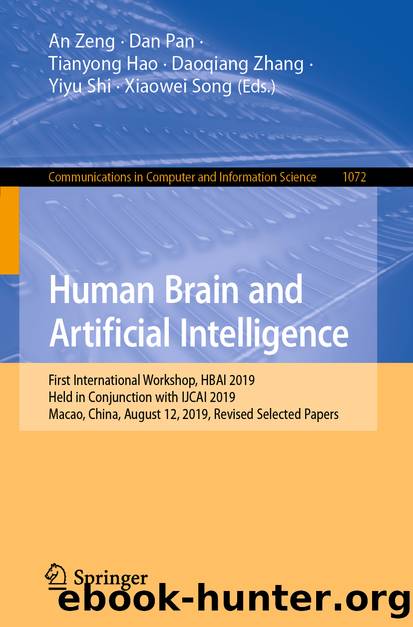Human Brain and Artificial Intelligence by Unknown

Author:Unknown
Language: eng
Format: epub
ISBN: 9789811513985
Publisher: Springer Singapore
5 Discussion
As you saw, we got three consistent physical representation systems. The first one, for single isolated particle, under the “continuum hypothesis” (CH) assumption, considers Position (P) energy conservation as the fundamental components for useful physical representation and the Planck’s quantum of action A as the “unit of uncertainty.” This worldview is the core of classic scientific knowledge and engineering applications at system macroscale level, inherited from the past century (Science 1.0 approach).
The second one, related to single particle system interaction, under the “discreteness hypothesis” (DH) assumption, assumes Time (T) as the fundamental component for choice of direction and the Planck’s quantum of action as DE or “unit of purpose.” It allows to build combinatorial pre-spatial arithmetic scheme to overcome and minimize the traditional statistical modeling veil opacity, typical of Science 1.0 approaches. It is the fresh, elementary QFT (quantum field theory) approach offered by Computational Information Conservation Theory (CICT) [36].
The third one, for multiple-particle system interactions, can be treated under CH or DH, according to your system representation and desired results. If the number of particles or quanta is well defined, we obtain an atomistic description of the system, but we lose the information on its capability to fluctuate. If the phase is well-defined, we obtain a description of the movement of the system, but we lose the information on its particle-like features which become undefined since ΔN becomes infinite.
Unfortunately, over the centuries, the above two large scientific research areas (CH based and DH based) have followed separate mathematical development paths with no or quite little, inconsistent synergistic coupling. That is the main reason why QFT is still mostly overlooked by traditional scientific and engineering researchers for arbitrary multi-scale system modeling, from system nano-microscale to macroscale. Unfortunately, the “statistical veil” can be very opaque computationally, in a continuum-discrete arbitrary multi-scale environment, and misplaced precision leads to information dissipation and confusion.
The CICT framework can help us to develop strategies to gather much more reliable experimental information from single experiment and to conserve overall system information. In this way, coherent representation precision leads to information conservation and clarity. The latest CICT claim has been that the “external” world real system physical manifestation properties and related human perception are HG (hyperbolic geometry) scale related representation based, while Euclidean approximated locally.
Science wants to know the origin of the universe, which it currently assumes, according to Science 1.0 interpretation, was the Big Bang. It seeks for fundamental particles, looks for invariants or for pulsars billions of light years away, and tries to fill the vacuum left by philosophy and religion, much as the wren, a small bird, fills the birdhouse made for large birds with space-filling straw.
Today, to solve complex, arbitrary multiscale system problems, we need a unified, integrated mathematical language that can offer an effective and convenient universal framework, by considering information not only on the statistical manifold of model states, but also on the combinatorical manifold of low-level discrete, directed energy generators and empirical measures of noise sources, related to experimental high-level overall perturbation.
Download
This site does not store any files on its server. We only index and link to content provided by other sites. Please contact the content providers to delete copyright contents if any and email us, we'll remove relevant links or contents immediately.
POP by Steven Heller(3327)
Japanese Design by Patricia J. Graham(3139)
The Power of Broke by Daymond John(2936)
Architecture 101 by Nicole Bridge(2783)
Indistractable: How to Control Your Attention and Choose Your Life by Nir Eyal(2360)
Fusion 360 for Makers by Lydia Sloan Cline(2338)
Batik by Rudolf Smend(2155)
Actionable Gamification: Beyond Points, Badges, and Leaderboards by Yu-kai Chou(2143)
Origami Art by Michael G. Lafosse & Richard L. Alexander(2081)
Homebody by Joanna Gaines(2050)
Whiskey in a Teacup by Reese Witherspoon(1957)
Worn in New York by Emily Spivack(1946)
Feng Shui by Stephen Skinner(1920)
Austin Kleon by Steal Like an Artist(1910)
Simple Gatherings by Melissa Michaels(1886)
Don't Make Me Think, Revisited: A Common Sense Approach to Web Usability by Steve Krug(1843)
Ryan Korban by Ryan Korban(1736)
Hygge: The Danish Art of Happiness by Marie Tourell Søderberg(1713)
The Joy of Hygge by Jonny Jackson(1708)
